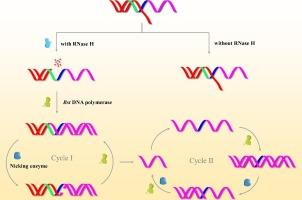Highly sensitive detection of RNase H via a novel DNA/RNA heteroduplex combining isothermal exponential amplification strategy
IF 4.9
2区 化学
Q1 CHEMISTRY, ANALYTICAL
引用次数: 0
Abstract
Ribonuclease H (RNase H) plays a crucial role in a variety of cellular processes and is emerging as an essential therapeutic target for many diseases. Various methods have been constructed to assay RNase H activity, but these methods are either time-consuming or have poor sensitivity. In this study, we developed a novel strategy that combined a specially designed DNA/RNA chimeric substrate with exponential amplification reaction (EXPAR) for rapid and sensitive detection of RNase H activity. In the presence of RNase H, the RNA strand of the DNA/RNA heteroduplex was specifically degraded, forming a 3′-hydroxyl group in the locking primer for recognition and extension by DNA polymerase. This ultimately triggered EXPAR and produced a large number of single-stranded DNA, which was monitored in real-time with fluorescent dye. Under optimized conditions, the proposed strategy can detect as low as 6 × 10−10 U/μL of RNase H, which was at least 1000 times more sensitive than several reported methods. Furthermore, we demonstrated the usage of this method for RNase H inhibitor analysis and practical application in complex biological samples, including serum and tumor cell extracts. Therefore, these results suggested that the developed method is a promising tool for highly sensitive detection of RNase H and RNase H-associated disease diagnosis.

通过结合等温指数扩增策略的新型 DNA/RNA 异质双链对 RNase H 进行高灵敏度检测
核糖核酸酶 H(RNase H)在多种细胞过程中发挥着至关重要的作用,正在成为许多疾病的重要治疗靶点。目前已经构建了多种方法来检测 RNase H 的活性,但这些方法要么耗时长,要么灵敏度低。在这项研究中,我们开发了一种新策略,将专门设计的 DNA/RNA 嵌合底物与指数扩增反应(EXPAR)相结合,快速灵敏地检测 RNase H 的活性。在 RNase H 的存在下,DNA/RNA 异源双链的 RNA 链被特异性降解,在锁定引物中形成一个 3′-羟基,供 DNA 聚合酶识别和延伸。这最终触发了 EXPAR,产生了大量单链 DNA,并用荧光染料对其进行实时监测。在优化的条件下,所提出的策略可以检测到低至 6 × 10-10 U/μL 的 RNase H,其灵敏度比已报道的几种方法至少高出 1000 倍。此外,我们还展示了该方法在 RNase H 抑制剂分析中的应用,以及在复杂生物样本(包括血清和肿瘤细胞提取物)中的实际应用。因此,这些结果表明,所开发的方法在高灵敏度检测 RNase H 和 RNase H 相关疾病诊断方面是一种很有前途的工具。
本文章由计算机程序翻译,如有差异,请以英文原文为准。
求助全文
约1分钟内获得全文
求助全文
来源期刊

Microchemical Journal
化学-分析化学
CiteScore
8.70
自引率
8.30%
发文量
1131
审稿时长
1.9 months
期刊介绍:
The Microchemical Journal is a peer reviewed journal devoted to all aspects and phases of analytical chemistry and chemical analysis. The Microchemical Journal publishes articles which are at the forefront of modern analytical chemistry and cover innovations in the techniques to the finest possible limits. This includes fundamental aspects, instrumentation, new developments, innovative and novel methods and applications including environmental and clinical field.
Traditional classical analytical methods such as spectrophotometry and titrimetry as well as established instrumentation methods such as flame and graphite furnace atomic absorption spectrometry, gas chromatography, and modified glassy or carbon electrode electrochemical methods will be considered, provided they show significant improvements and novelty compared to the established methods.
 求助内容:
求助内容: 应助结果提醒方式:
应助结果提醒方式:


